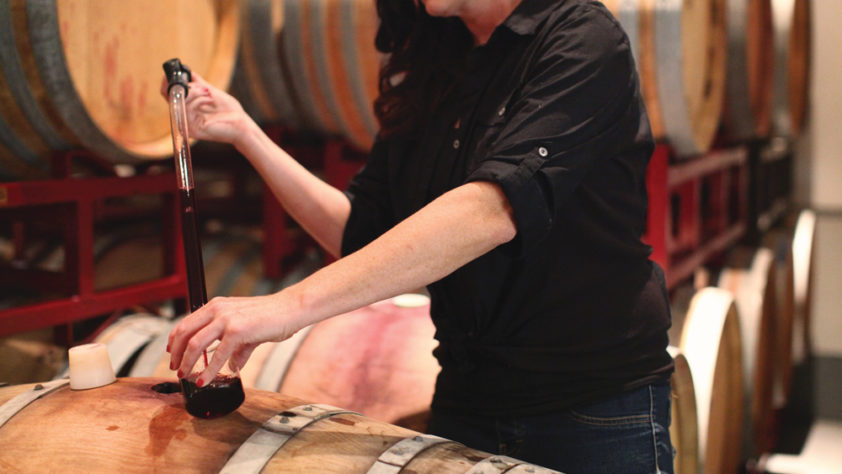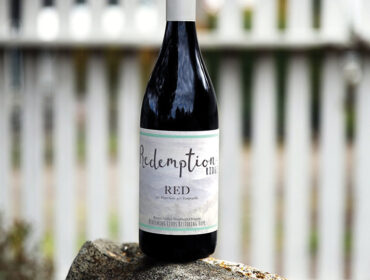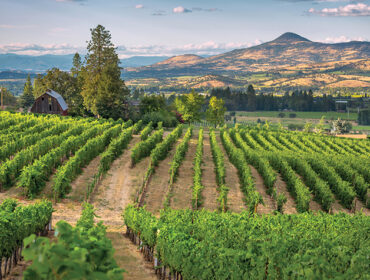
The Grape in Your Glass: Touriga Nacional and Tinto Cão – by MJ Daspit
IF YOU’VE EVER OPTED FOR A DESSERT WINE AFTER DINNER, you‘ve probably encountered these Portuguese red varieties. Touriga Nacional is the primary ingredient of Port, and is often blended with Tinto Cão. Both are grown locally and made by a few Rogue Valley winemakers into Port-style and dry table wines.
What distinguishes a dessert wine from a table wine made of the same grape variety? The dessert wine is not fermented to dryness. When the fermentation process is still ongoing, high-proof alcohol is added to kill the yeast, arresting fermentation and leaving residual sugar in the wine. This process results in a sweet wine with relatively high alcohol—typically 18%-20%.
Rachael Martin, winemaker and co-owner of the Applegate Valley’s Red Lily Vineyards, first tried her hand at making a Port-style dessert wine using fruit from Randy Gold’s Gold Vineyard in Talent. “He was growing Touriga Nacional and Tinto Cão which is another traditional Portuguese variety,” Martin recalls. “I bought those for the first time from him in 2013 and I had no idea what to expect. It’s one of those situations where you can do a lot of reading about it but you just don’t know what you have until you’re working with it—how it’s going to behave in the vineyard, how it’s going to ripen, any kind of trends it follows, or how it behaves in the winery. I spent so many years focusing on Tempranillo I’ve got this palate memory of how I want Tempranillo to taste. But with Touriga and Tinto Cão, I was completely winging it.”
Tackling this learning experience inspired the name of her Port-style wine. “It’s called ‘Night School’ because it was the first time I had made it, so it felt like going back to school. The other reason it’s called Night School is I stayed up all night. There’s something so exhilarating about adding 160-proof pure grain alcohol to something in the middle of the night. Something feels right about that.”
Fortunately the wine industry in the Rogue Valley is highly cooperative such that winemakers often share knowledge and support each other. “I had a lot of help from Eric Weisinger on my project. He walked me through what to expect and how it was going to taste at different stages, not to be afraid if it tasted pretty disjointed at certain parts of its life. I remember Eric telling me, the first time you try it, after you add your high proof, it’s going to be over the top crazy and you should just turn off the light and go to bed.”
Given a little aging, and a touch of Tempranillo, that 2013 dessert wine that was all elbows and knees at first came together beautifully. In 2014, Rachael decided to expand her understanding of the Portuguese varieties by making both a Port-style and a dry table wine from the same harvest. “When you’re making Port, you arrest fermentation with your high proof alcohol, so you don’t get to see the whole span of it as you do when it ferments out dry. Fermented to dryness, Touriga Nacional is really interesting because it’s got a lot of structure and tannin. It’s sort of a beastly red but at the same time it’s really floral. If I had to compare it to something, a red variety that we’re more familiar with, it would be Cabernet Franc with its structure and really concentrated black fruit with a floral, violet mineral piece to it. There’s almost a disconnect between the aroma and the palate profile.”
Martin’s dry wine made from Touriga Nacional, Tinto Cão and Tempranillo is called Fibonacci, “because my daughter explained to me about the Fibonacci sequence, the mathematical equation of symmetry in nature. I thought that was a really beautiful name.”
Martin is open to making wines from other little- known grapes in future. “Southern Oregon is so amazing because there are so many varieties that we are able to produce. For a winemaker, the world is your oyster here. You have to have the right site, of course, but if I came up with some crazy idea of a variety I wanted to try, we could pull it off here. It’s fun in your tasting room to have a wine that’s obscure. Like Troon with Vermentino—it’s like I need to try that! It’s fun.”
Elsewhere in the Rogue Valley, other wineries that feature these varietals include Schmidt Family Vineyards, where the emphasis is on making a dry table wine of Touriga Nacional. Fruit from Pavo Real vineyard in Ruch was used to produce the Schmidt 2014 Touriga Nacional. It took Double Gold at the San Francisco Chronicle International Wine Competition and the Texas International Wine Competition and received 90 points and Editor’s Choice from Wine Enthusiast. Cuttings from Pavo Real have been planted at Schmidt with the first harvest expected in 2020.
At Belle Fiore Winery & Vineyard, winemakers made a Port-style wine from Gold Vineyards’ Touriga Nacional, Tinto Cão and Tinta Barroca in 2017. With a subtle orange blossom aroma and deep color it’s sure to be a winner when released sometime after bottling in 2019.
©Southern Oregon Wine Scene
Fall Winter 2018 issue
Related Post
RoxyAnn Winery–Making a Difference with Redemption...
Update to this article on 07/29/21 – “… the Board of Directors of Redemption Ridge have made the difficult decision to clo...
Awen Winecraft: An Inspirational New Reason...
As if you needed another reason to visit historic Jacksonville, now there’s another draw—Awen Winecraft’s new tasting room located at ...
Rogue Valley Rising – by Valerie...
MEDFORD, OREGON’S star is rising on the world stage as it rapidly becomes a top destination for connoisseurs of fine wine and for enthusia...




